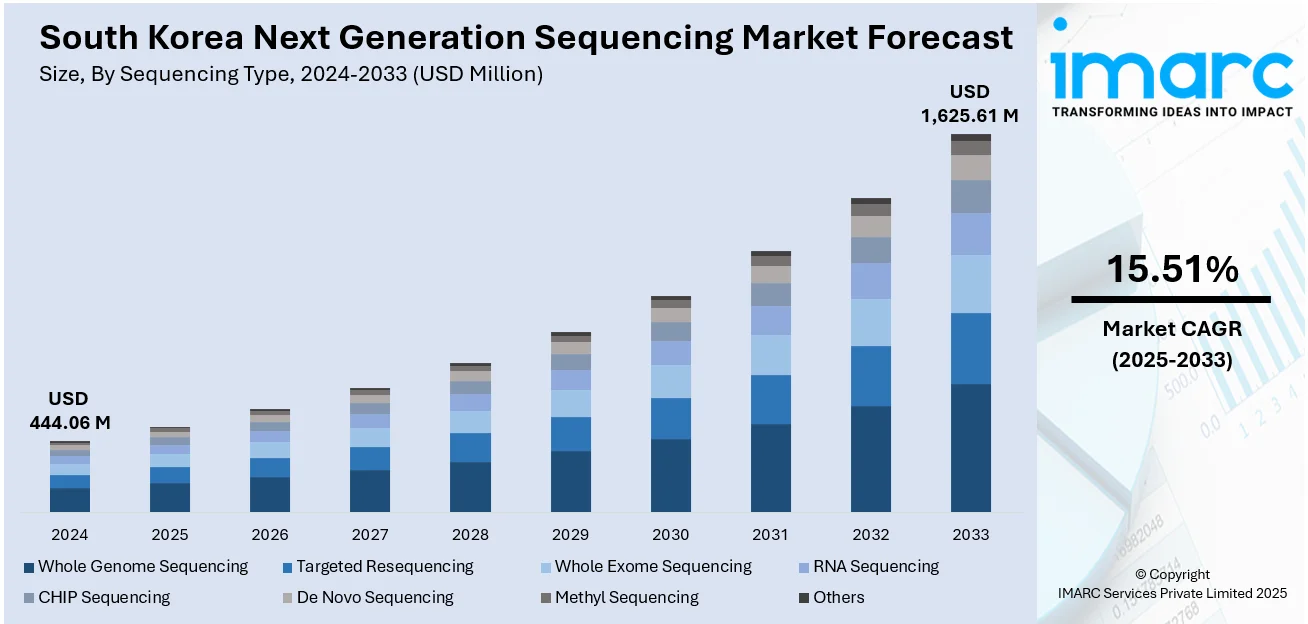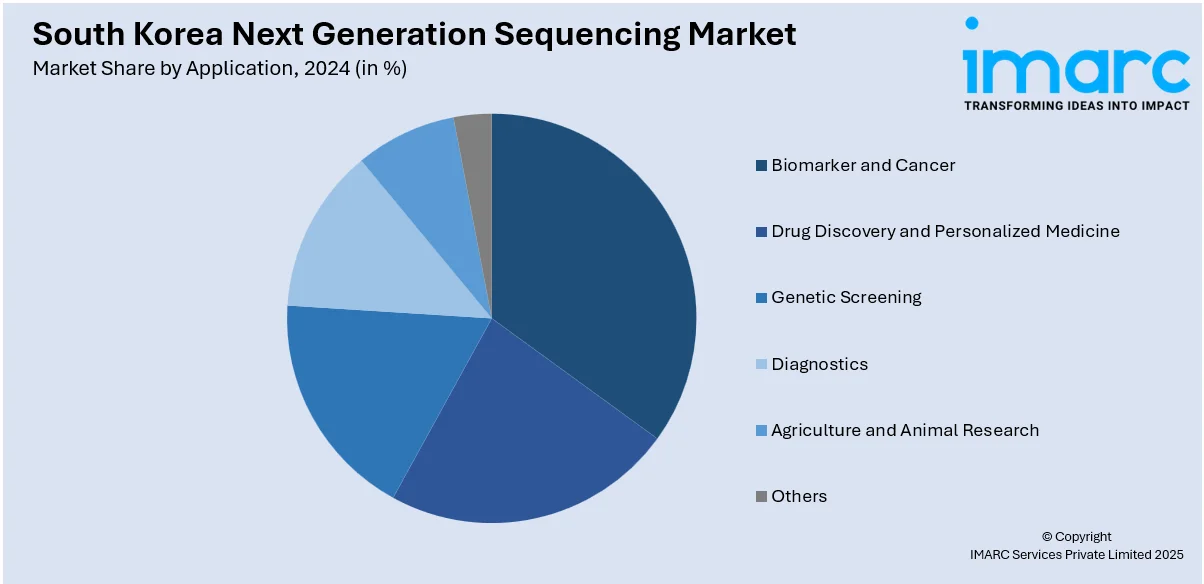
South Korea Next Generation Sequencing Market Size, Share, Trends and Forecast by Sequencing Type, Product Type, Technology, Application, End User, and Region, 2025-2033
South Korea Next Generation Sequencing Market Overview:
The South Korea next generation sequencing market size reached USD 444.06 Million in 2024. Looking forward, the market is expected to reach USD 1,625.61 Million by 2033, exhibiting a growth rate (CAGR) of 15.51% during 2025-2033. The growth of the market is driven by advancements in genomics, personalized medicine, and cancer research. Government support and improved accuracy, speed, and affordability of sequencing technologies are expanding applications across healthcare, agriculture, and research, thereby enhancing South Korea next generation sequencing market share.
|
Report Attribute
|
Key Statistics
|
|---|---|
|
Base Year
|
2024
|
|
Forecast Years
|
2025-2033
|
|
Historical Years
|
2019-2024
|
|
Market Size in 2024
|
USD 444.06 Million |
|
Market Forecast in 2033
|
USD 1,625.61 Million |
| Market Growth Rate 2025-2033 | 15.51% |
South Korea Next Generation Sequencing Market Trends:
Increase in Applications for Cancer Research
In the discipline of cancer research, the next generation sequencing (NGS) market in South Korea is expanding significantly. NGS has become a crucial technique for detecting genetic mutations and changes in cancer cells due to advancements in genomics. NGS is being used by researchers to predict patient responses to treatment, comprehend tumor heterogeneity, and identify new biomarkers for early cancer diagnosis. The growing demand for tailored cancer treatments is the driving force behind this movement, as NGS offers comprehensive genetic insights that support the creation of customized therapy regimens. As per industry reports, in 2024, Korea is expected to report 292,221 new cancer cases and 83,770 cancer-related deaths. With cancer being a leading cause of death in South Korea, the demand for NGS in oncology research is expected to continue its upward trajectory, further contributing to South Korea next generation sequencing market growth.

To get more information on this market, Request Sample
Rising Demand for Personalized Medicine
One of the main factors propelling the Next Generation Sequencing (NGS) market in South Korea is personalized medicine. Through the examination of individual genetic profiles made possible by NGS technology, doctors can better customize therapies based on genetic variants, increasing therapeutic efficacy and reducing side effects. NGS-based diagnostic techniques are in greater demand due to the growing emphasis on individualized treatment strategies, especially in oncology, rare disorders, and pharmacogenomics. The use of NGS for customized treatment in South Korea is also being accelerated by government programs and investments in medical technology. NGS is anticipated to play a crucial role in promoting personalized medicine as the healthcare industry shifts to more targeted therapies, which will greatly contribute to the growth of the next generation sequencing market in South Korea. For instance, in May 2025, Twist Bioscience and Element Biosciences expanded their collaboration to offer end-to-end sequencing workflows, from library prep to sequencing, using Element's AVITI platform. Twist will exclusively provide library prep and target enrichment workflows for Element’s Trinity sequencing technology. This partnership aims to improve access to high-quality, cost-effective next-generation sequencing tools for researchers, enhancing scientific discoveries across multiple fields.
South Korea Next Generation Sequencing Market Segmentation:
IMARC Group provides an analysis of the key trends in each segment of the market, along with forecasts at the country and regional levels for 2025-2033. Our report has categorized the market based on sequencing type, product type, technology, application, and end user.
Sequencing Type Insights:
- Whole Genome Sequencing
- Targeted Resequencing
- Whole Exome Sequencing
- RNA Sequencing
- CHIP Sequencing
- De Novo Sequencing
- Methyl Sequencing
- Others
The report has provided a detailed breakup and analysis of the market based on the sequencing type. This includes whole genome sequencing, targeted resequencing, whole exome sequencing, RNA sequencing, CHIP sequencing, de novo sequencing, methyl sequencing, and others.
Product Type Insights:
- Instruments
- Reagents and Consumables
- Software and Services
A detailed breakup and analysis of the market based on the product type have also been provided in the report. This includes instruments, reagents and consumables, and software and services.
Technology Insights:
- Sequencing by Synthesis
- Ion Semiconductor Sequencing
- Single-Molecule Real-Time Sequencing
- Nanopore Sequencing
- Others
A detailed breakup and analysis of the market based on technology have also been provided in the report. This includes sequencing by synthesis, ion semiconductor sequencing, single-molecule real-time sequencing, nanopore sequencing, and others.
Application Insights:

- Biomarker and Cancer
- Drug Discovery and Personalized Medicine
- Genetic Screening
- Diagnostics
- Agriculture and Animal Research
- Others
The report has provided a detailed breakup and analysis of the market based on the application. This includes biomarker and cancer, drug discovery and personalized medicine, genetic screening, diagnostics, agriculture and animal research, and others.
End User Insights:
- Academic Institutes and Research Centers
- Hospitals and Clinics
- Pharmaceutical and Biotechnology Companies
- Others
A detailed breakup and analysis of the market based on the end user have also been provided in the report. This includes academic institutes and research centers, hospitals and clinics, pharmaceutical and biotechnology companies, and others.
Regional Insights:
- Seoul Capital Area
- Yeongnam (Southeastern Region)
- Honam (Southwestern Region)
- Hoseo (Central Region)
- Others
The report has also provided a comprehensive analysis of all the major regional markets, which include Seoul Capital Area, Yeongnam (Southeastern Region), Honam (Southwestern Region), Hoseo (Central Region), and others.
Competitive Landscape:
The market research report has also provided a comprehensive analysis of the competitive landscape. Competitive analysis such as market structure, key player positioning, top winning strategies, competitive dashboard, and company evaluation quadrant has been covered in the report. Also, detailed profiles of all major companies have been provided.
South Korea Next Generation Sequencing Market News:
- In June 2025, Novogene, a global leader in next-generation sequencing (NGS) and multi-omics solutions, established a subsidiary, Novogene Korea Limited, in Seoul to accelerate multi-omics research. This expansion allows for local support, faster project timelines, and enhanced collaboration with South Korea's vibrant scientific community. Novogene will focus on genomics, precision medicine, cancer research, and agricultural studies, offering cost-effective services backed by the country’s robust biotech ecosystem.
- In April 2024, New England Biolabs (NEB) launched a subsidiary, NEB Korea, in South Korea to enhance local access to its products and support. This expansion comes as South Korea's life sciences industry grows, bolstered by public and private sector investments. NEB Korea will offer efficient services and custom partnership opportunities for researchers.
South Korea Next Generation Sequencing Market Report Coverage:
| Report Features | Details |
|---|---|
| Base Year of the Analysis | 2024 |
| Historical Period | 2019-2024 |
| Forecast Period | 2025-2033 |
| Units | Million USD |
| Scope of the Report | Exploration of Historical and Forecast Trends, Industry Catalysts and Challenges, Segment-Wise Historical and Predictive Market Assessment:
|
| Sequencing Types Covered | Whole Genome Sequencing, Targeted Resequencing, Whole Exome Sequencing, RNA Sequencing, CHIP Sequencing, De Novo Sequencing, Methyl Sequencing, Others |
| Product Types Covered | Instruments, Reagents and Consumables, Software and Services |
| Technologies Covered | Sequencing by Synthesis, Ion Semiconductor Sequencing, Single-Molecule Real-Time Sequencing, Nanopore Sequencing, Others |
| Applications Covered | Biomarker and Cancer, Drug Discovery and Personalized Medicine, Genetic Screening, Diagnostics, Agriculture and Animal Research, Others |
| End Users Covered | Academic Institutes and Research Centers, Hospitals and Clinics, Pharmaceutical and Biotechnology Companies, Others |
| Regions Covered | Seoul Capital Area, Yeongnam (Southeastern Region), Honam (Southwestern Region), Hoseo (Central Region), Others |
| Customization Scope | 10% Free Customization |
| Post-Sale Analyst Support | 10-12 Weeks |
| Delivery Format | PDF and Excel through Email (We can also provide the editable version of the report in PPT/Word format on special request) |
Key Questions Answered in This Report:
- How has the South Korea next generation sequencing market performed so far and how will it perform in the coming years?
- What is the breakup of the South Korea next generation sequencing market on the basis of sequencing type?
- What is the breakup of the South Korea next generation sequencing market on the basis of product type?
- What is the breakup of the South Korea next generation sequencing market on the basis of technology?
- What is the breakup of the South Korea next generation sequencing market on the basis of application?
- What is the breakup of the South Korea next generation sequencing market on the basis of end user?
- What is the breakup of the South Korea next generation sequencing market on the basis of region?
- What are the various stages in the value chain of the South Korea next generation sequencing market?
- What are the key driving factors and challenges in the South Korea next generation sequencing market?
- What is the structure of the South Korea next generation sequencing market and who are the key players?
- What is the degree of competition in the South Korea next generation sequencing market?
Key Benefits for Stakeholders:
- IMARC’s industry report offers a comprehensive quantitative analysis of various market segments, historical and current market trends, market forecasts, and dynamics of the South Korea next generation sequencing market from 2019-2033.
- The research report provides the latest information on the market drivers, challenges, and opportunities in the South Korea next generation sequencing market.
- Porter's five forces analysis assist stakeholders in assessing the impact of new entrants, competitive rivalry, supplier power, buyer power, and the threat of substitution. It helps stakeholders to analyze the level of competition within the South Korea next generation sequencing industry and its attractiveness.
- Competitive landscape allows stakeholders to understand their competitive environment and provides an insight into the current positions of key players in the market.
Need more help?
- Speak to our experienced analysts for insights on the current market scenarios.
- Include additional segments and countries to customize the report as per your requirement.
- Gain an unparalleled competitive advantage in your domain by understanding how to utilize the report and positively impacting your operations and revenue.
- For further assistance, please connect with our analysts.
 Request Customization
Request Customization
 Speak to an Analyst
Speak to an Analyst
 Request Brochure
Request Brochure
 Inquire Before Buying
Inquire Before Buying




.webp)




.webp)












